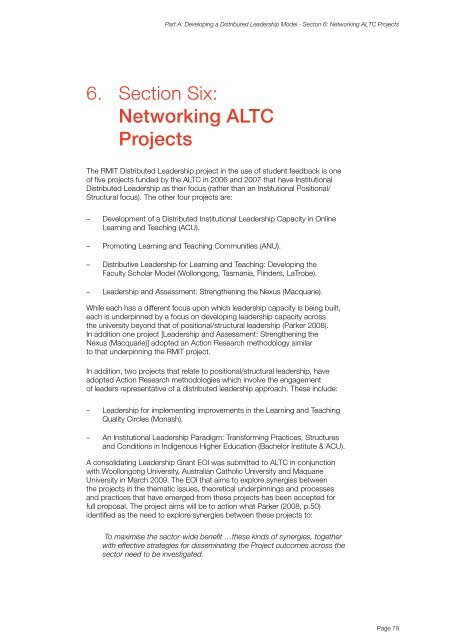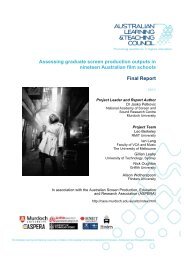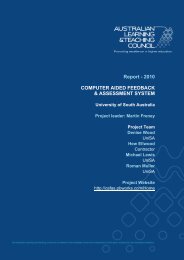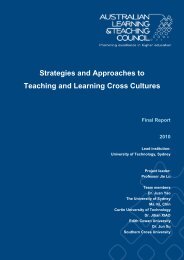student feedback and leadership - Office for Learning and Teaching
student feedback and leadership - Office for Learning and Teaching
student feedback and leadership - Office for Learning and Teaching
Create successful ePaper yourself
Turn your PDF publications into a flip-book with our unique Google optimized e-Paper software.
Part A: Developing a Distributed Leadership Model - Secton 6: Networking ALTC Projects6. Section Six:Networking ALTCProjectsThe RMIT Distributed Leadership project in the use of <strong>student</strong> <strong>feedback</strong> is oneof five projects funded by the ALTC in 2006 <strong>and</strong> 2007 that have InstitutionalDistributed Leadership as their focus (rather than an Institutional Positional/Structural focus). The other four projects are:––Development of a Distributed Institutional Leadership Capacity in Online<strong>Learning</strong> <strong>and</strong> <strong>Teaching</strong> (ACU).––Promoting <strong>Learning</strong> <strong>and</strong> <strong>Teaching</strong> Communities (ANU).––Distributive Leadership <strong>for</strong> <strong>Learning</strong> <strong>and</strong> <strong>Teaching</strong>: Developing theFaculty Scholar Model (Wollongong, Tasmania, Flinders, LaTrobe).––Leadership <strong>and</strong> Assessment: Strengthening the Nexus (Macquarie).While each has a different focus upon which <strong>leadership</strong> capacity is being built,each is underpinned by a focus on developing <strong>leadership</strong> capacity acrossthe university beyond that of positional/structural <strong>leadership</strong> (Parker 2008).In addition one project [Leadership <strong>and</strong> Assessment: Strengthening theNexus (Macquarie)] adopted an Action Research methodology similarto that underpinning the RMIT project.In addition, two projects that relate to positional/structural <strong>leadership</strong>, haveadopted Action Research methodologies which involve the engagementof leaders representative of a distributed <strong>leadership</strong> approach. These include:––Leadership <strong>for</strong> implementing improvements in the <strong>Learning</strong> <strong>and</strong> <strong>Teaching</strong>Quality Circles (Monash).––An Institutional Leadership Paradigm: Trans<strong>for</strong>ming Practices, Structures<strong>and</strong> Conditions in Indigenous Higher Education (Bachelor Institute & ACU).A consolidating Leadership Grant EOI was submitted to ALTC in conjunctionwith Woollongong University, Australian Catholic University <strong>and</strong> MaquarieUniversity in March 2009. The EOI that aims to explore synergies betweenthe projects in the thematic issues, theoretical underpinnings <strong>and</strong> processes<strong>and</strong> practices that have emerged from these projects has been accepted <strong>for</strong>full proposal. The project aims will be to action what Parker (2008, p.50)identified as the need to explore synergies between these projects to:To maximise the sector-wide benefit …these kinds of synergies, togetherwith effective strategies <strong>for</strong> disseminating the Project outcomes across thesector need to be investigated.Page 79
















